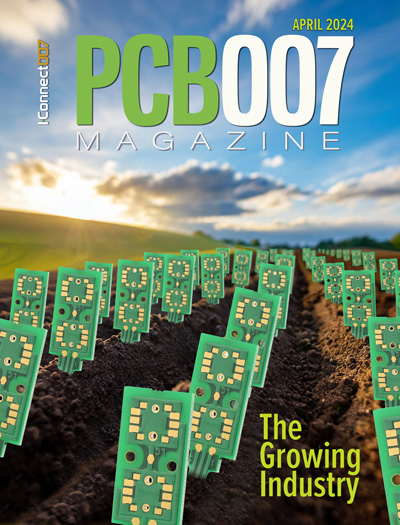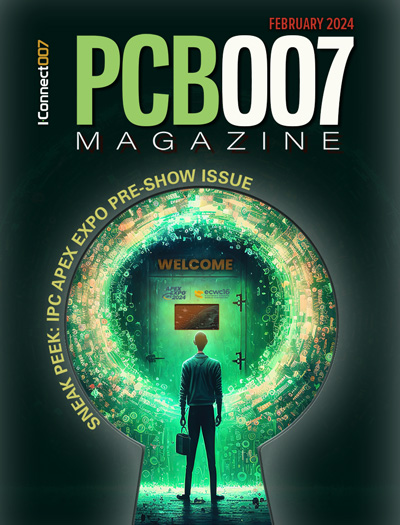-

- News
- Books
Featured Books
- pcb007 Magazine
Latest Issues
Current Issue
The Growing Industry
In this issue of PCB007 Magazine, we talk with leading economic experts, advocacy specialists in Washington, D.C., and PCB company leadership to get a well-rounded picture of what’s happening in the industry today. Don’t miss it.

The Sustainability Issue
Sustainability is one of the most widely used terms in business today, especially for electronics and manufacturing but what does it mean to you? We explore the environmental, business, and economic impacts.

The Fabricator’s Guide to IPC APEX EXPO
This issue previews many of the important events taking place at this year's show and highlights some changes and opportunities. So, buckle up. We are counting down to IPC APEX EXPO 2024.
- Articles
- Columns
Search Console
- Links
- Events
||| MENU - pcb007 Magazine
A Thermal Conductivity Measurement Method, Adapted to Composite Materials Used in the PCB Industry
July 25, 2016 | François Lechleiter, CIMULEC GROUP and Yves Jannot, UNIVERSITÉ DE LORRAINE, LEMTA CNRSEstimated reading time: 1 minute
Abstract
Most of today’s printed circuit board base materials are anisotropic and it is not possible to use a simple method to measure thermal conductivity along the different axes, especially when a good accuracy is expected. Few base material suppliers’ datasheets show X, Y and Z thermal conductivities. In most cases, a single value is given, moreover determined with a generic methodology, and not necessarily adapted to the reality of glass-reinforced composites with a strong anisotropy.
After reminding the fundamentals in thermal science, this paper gives a short overview of the state-of the art in terms of thermal conductivity measurement on PCB base materials, and some typical values. It finally proposes an innovative method called transient fin method, and associated test sample, to perform reliable and consistent in-plane thermal conductivity measurement on anisotropic PCB base materials.
Introduction
Observed on a long enough time scale, electronic systems behave like living species; they obey the laws of evolution. To be successful, they have to adapt to their environment, which means to market requirements, and thus to consumer expectations. Any system with a new, more powerful functionality naturally surpasses the previous generation. As consumers, we normally prefer smaller, lighter, faster, more reliable and cheaper electronic systems. This has led the electronic industry since its beginning.
The PCB progressively becomes a little bit more than just the backbone of electronic systems. At the beginning, the printed circuit board was providing essentially an electrical function, by interconnecting electrically components together, and a mechanical function, by supporting mechanically the components and holding them into a defined volume. Progressively, evolution towards microwave applications brought electromagnetic functionalities to the PCB. In addition, the constant increase of power density made the PCB more and more capable of providing solutions for efficient thermal management strategy.
To read this entire article, which appeared in the July 2016 issue of The PCB Magazine, click here.
Suggested Items
KIC’s Miles Moreau to Present Profiling Basics and Best Practices at SMTA Wisconsin Chapter PCBA Profile Workshop
01/25/2024 | KICKIC, a renowned pioneer in thermal process and temperature measurement solutions for electronics manufacturing, announces that Miles Moreau, General Manager, will be a featured speaker at the SMTA Wisconsin Chapter In-Person PCBA Profile Workshop.
The Drive Toward UHDI and Substrates
09/20/2023 | I-Connect007 Editorial TeamPanasonic’s Darren Hitchcock spoke with the I-Connect007 Editorial Team on the complexities of moving toward ultra HDI manufacturing. As we learn in this conversation, the number of shifting constraints relative to traditional PCB fabrication is quite large and can sometimes conflict with each other.
Standard Of Excellence: The Products of the Future
09/19/2023 | Anaya Vardya -- Column: Standard of ExcellenceIn my last column, I discussed cutting-edge innovations in printed circuit board technology, focusing on innovative trends in ultra HDI, embedded passives and components, green PCBs, and advanced substrate materials. This month, I’m following up with the products these new PCB technologies are destined for. Why do we need all these new technologies?
Experience ViTrox's State-of-the-Art Offerings at SMTA Guadalajara 2023 Presented by Sales Channel Partner—SMTo Engineering
09/18/2023 | ViTroxViTrox, which aims to be the world’s most trusted technology company, is excited to announce that our trusted Sales Channel Partner (SCP) in Mexico, SMTo Engineering, S.A. de C.V., will be participating in SMTA Guadalajara Expo & Tech Forum. They will be exhibiting in Booth #911 from the 25th to the 26th of October 2023, at the Expo Guadalajara in Jalisco, Mexico.
Intel Unveils Industry-Leading Glass Substrates to Meet Demand for More Powerful Compute
09/18/2023 | IntelIntel announced one of the industry’s first glass substrates for next-generation advanced packaging, planned for the latter part of this decade.


